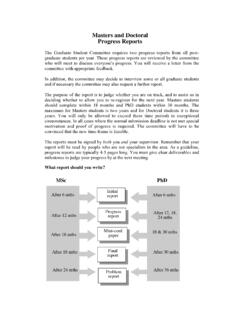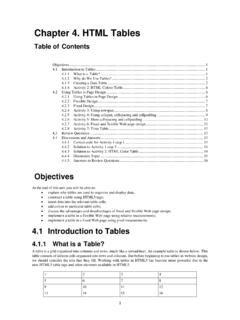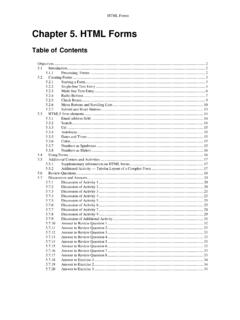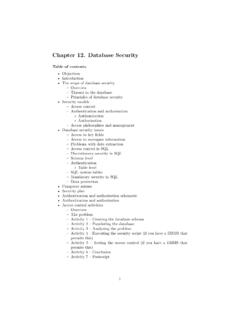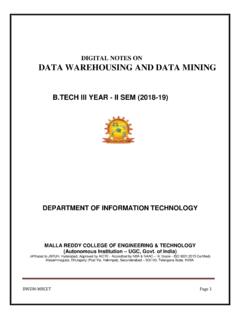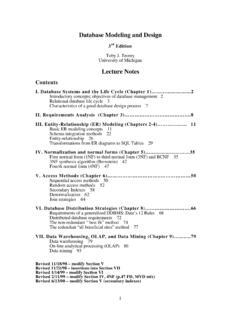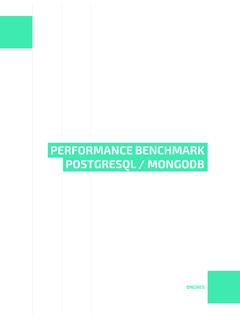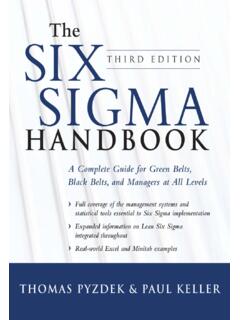Transcription of Chapter 19. Data Warehousing and Data Mining
1 Chapter 19. data Warehousing and data MiningTable of contents Objectives Context General introduction to data Warehousing What is a data warehouse? Operational systems vs. data Warehousing systems Operational systems data Warehousing systems Differences between operational and data Warehousing systems Benefits of data Warehousing systems data warehouse architecture Overall architecture The data warehouse data transformation Metadata Access tools Query and reporting tools Application development tools Executive information systems (EIS) tools OLAP data Mining tools data visualisation data marts Information delivery system data warehouse blueprint data architecture Volumetrics Transformation data cleansing data architecture requirements Application architecture Requirements of tools Technology architecture Star schema design Entities within a data warehouse Measure entities Dimension entities Category detail entities Translating information into a star schema data extraction and cleansing Extraction specifications Loading data Multiple passes of data1 Staging area Checkpoint restart logic data loading data Warehousing and data Mining General introduction to data Mining data
2 Mining concepts Benefits of data Mining Comparing data Mining with other techniques Query tools vs. data Mining tools OLAP tools vs. data Mining tools Website analysis tools vs. data Mining tools data Mining tasks Techniques for data Mining data Mining directions and trends data Mining process The process overview The process in detail Business objectives determination data preparation data selection data pre-processing data transformation data Mining Analysis of results Assimilation of knowledge data Mining algorithms From application to algorithm Popular data Mining techniques Decision trees Neural networks Supervised learning Preparing data Unsupervised learning - self-organising map (SOM) Discussion topicsObjectivesAt the end of this Chapter you should be able to.
3 Distinguish a data warehouse from an operational database system, andappreciate the need for developing a data warehouse for large corporations. Describe the problems and processes involved in the development of a datawarehouse. Explain the process of data Mining and its Understand different data Mining developments in information technology have resulted in the constructionof many business application systems in numerous areas. Within these systems,databases often play an essential role. data has become a critical resource inmany organisations, and therefore, efficient access to the data , sharing the data ,extracting information from the data , and making use of the information stored,has become an urgent need.
4 As a result, there have been many efforts on firstlyintegrating the various data sources ( databases) scattered across differentsites to build a corporate data warehouse, and then extracting information fromthe warehouse in the form of patterns and data warehouse is very much like a database system, but there are distinctionsbetween these two types of systems. A data warehouse brings together theessential data from the underlying heterogeneous databases, so that a user onlyneeds to make queries to the warehouse instead of accessing individual co-operation of several processing modules to process a complex query ishidden from the , a data warehouse is built to provide decision support functions foran enterprise or an organisation.
5 For example, while the individual data sourcesmay have the raw data , the data warehouse will have correlated data , summaryreports, and aggregate functions applied to the raw data . Thus, the warehouseis able to provide useful information that cannot be obtained from any indi-vidual databases. The differences between the data Warehousing system andoperational databases are discussed later in the will also see what a data warehouse looks like its architecture and otherdesign issues will be studied. Important issues include the role of metadata aswell as various access tools. data warehouse development issues are discussedwith an emphasis on data transformation and data cleansing.
6 Star schema, apopular data modelling approach, is introduced. A brief analysis of the relation-ships between database, data warehouse and data Mining leads us to the secondpart of this Chapter - data Mining is a process of extracting information and patterns, which are pre-viously unknown, from large quantities of data using various techniques rangingfrom machine learning to statistical methods. data could have been stored infiles, Relational or OO databases, or data warehouses. In this Chapter , we willintroduce basic data Mining concepts and describe the data Mining process withan emphasis on data preparation. We will also study a number of data miningtechniques, including decision trees and neural will also study the basic concepts, principles and theories of data ware-housing and data Mining techniques, followed by detailed discussions.
7 Both3theoretical and practical issues are covered. As this is a relatively new andpopular topic in databases, you will be expected to do some extensive searching,reading and discussion during the process of studying this introduction to data warehousingIn parallel with this Chapter , you should read Chapter 31, Chapter 32 and Chap-ter 34 of Thomas Connolly and Carolyn Begg, Database Systems A PracticalApproach to Design, Implementation, and Management , (5th edn.).What is a data warehouse?A data warehouse is an environment, not a product. The motivation for build-ing a data warehouse is that corporate data is often scattered across differentdatabases and possibly in different formats.
8 In order to obtain a complete pieceof information, it is necessary to access these heterogeneous databases, obtainbits and pieces of partial information from each of them, and then put togetherthe bits and pieces to produce an overall picture. Obviously, this approach(without a data warehouse) is cumbersome, inefficient, ineffective, error-prone,and usually involves huge efforts of system analysts. All these difficulties deterthe effective use of complex corporate data , which usually represents a valuableresource of an order to overcome these problems, it is considered necessary to have an envi-ronment that can bring together the essential data from the underlying hetero-geneous databases.
9 In addition, the environment should also provide facilitiesfor users to carry out queries on all the data without worrying where it actu-ally resides. Such an environment is called a data warehouse. All queries areissued to the data warehouse as if it is a single database, and the warehousemanagement system will handle the evaluation of the techniques are used in data warehouses, all aimed at effective inte-gration of operational databases into an environment that enables strategic useof data . These techniques include Relational and multidimensional databasemanagement systems, client-server architecture, metadata modelling and repos-itories, graphical user interfaces, and much data warehouse system has the following characteristics: It provides a centralised utility of corporate data or information assets.
10 It is contained in a well-managed environment. It has consistent and repeatable processes defined for loading operationaldata. It is built on an open and scalable architecture that will handle futureexpansion of It provides tools that allow its users to effectively process the data intoinformation without a high degree of technical data warehouse is conceptually similar to a traditional centralised warehouseof products within the manufacturing industry. For example, a manufacturingcompany may have a number of plants and a centralised warehouse. Differentplants use different raw materials and manufacturing processes to manufacturegoods. The finished products from the plants will then be transferred to andstored in the warehouse.

